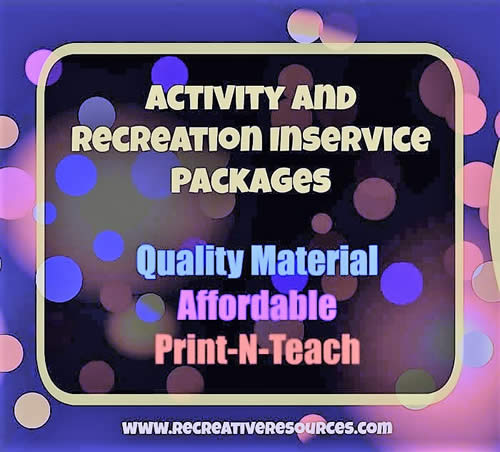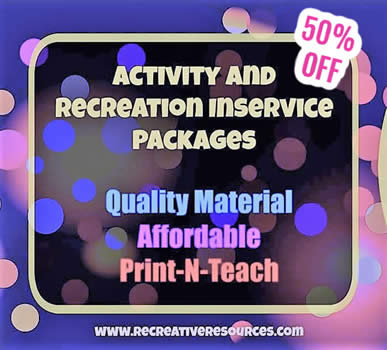 Providing training is one of the numerous responsibilities of the Recreation Director in a health care facility. Recreation Directors often state that they just do not have the time to train, but the needs and benefits of training are worthy of making an appearance in our monthly planners, and in many cases, a requirement. According to McNamara (2006) there are many benefits to training employees. Providing training is one of the numerous responsibilities of the Recreation Director in a health care facility. Recreation Directors often state that they just do not have the time to train, but the needs and benefits of training are worthy of making an appearance in our monthly planners, and in many cases, a requirement. According to McNamara (2006) there are many benefits to training employees.
Such benefits include:
- Increased job satisfaction and morale
- Increased employee motivation
- Increased efficiencies
- Increased capacity to adopt new methods
- Increased innovation in strategies
- Reduced employee turnover
- Enhanced company image
State and Federal regulations, as well as accrediting bodies such as JCAHO, require training and orientation programs in health care facilities. It is important to review these mandatory education requirements to ensure the Recreation Department is in compliance. Also, it is recommended that the Recreation Director review education requirements with the facility educator. The facility may require various additional mandatory education programs because of corporate standards, JCAHO, or even as part of a deficiency plan of correction. Although state regulations vary, some common mandatory in-services include: Tuberculosis/ Bloodborne Pathogens, Resident Rights, Advance Directives, Hand Washing/Hygiene, Fire and Safety/Disaster, Alzheimer Training and Abuse and Neglect.
Check out these great training resources
|
|
|
|
As an Amazon Associate I earn from qualifying purchases. |
So, with many benefits and requirements, why don’t managers, such as Recreation Directors, train their employees? As mentioned earlier, many managers state there is not enough time in the day. Training should be scheduled on a regular basis and should not be viewed as additional work. Set up training schedules such as a series of in-services, on a quarterly basis or as needed. Consider hiring a consultant or educator to help out in this area. In addition, Recreation Directors should consider making arrangements for employees to attend the MEPAP 2nd edition, outside workshops, conferences, and seminars.
Additional reasons why managers do not train their employees often include the lack of know-how and confidence to perform this duty. Practice makes perfect. Find a mentor, take a class, attend a seminar, research, etc. Educate yourself on training techniques. There is an abundance of free information and training resources available on the internet. Each time you train someone or a group of people, you gain experience, knowledge and eventually the confidence to continue. Many training programs require a lot of research, preparation, and planning, so give yourself plenty of time to organize your sessions. Other training may be spontaneous and be as a result of immediate intervention from management.
Lastly, many managers do not train their employees because there is a high turnover rate. This is of particular concern to the Recreation Profession, where burnout and turnover is very common. Interestingly enough, a good training program can actually decrease staff turnover because employees receive the necessary information they need to perform their job to the standards set forth by the manager.
There are many ways in which a Recreation Director could take on the role of educator. Remember, training does not have to occur in a formal, traditional atmosphere of sitting in rows looking at a Power Point presentation. When training employees, it is important to offer topics that are relevant to the work provided. In addition to the mandatory education set forth by the facility, consider the following activity-related topics:
- Documentation/IDCP
- Cognitively Impaired
- Precautions
- Adapting Activities
- Validation
- Parallel Programming
- 1x1 Programming
- Motivating Residents
- Culture Change
- Cognitive Activities
- Creative Activities
- Physical Activities
- Resident Committees
- Resident Volunteers
- Sensory Stimulation
|
- Spirituality vs. Religion
- Cultural Diversity
- Special Populations
- Regulatory Agencies
- Calendar Development
- Leadership Guidelines
- Diagnostic Information
- Role/benefits of Activities
- Van and Outings
- Policies and Procedures
- Equipment Use
- Computer Skills
- Professionalism
- Standards of Practice
- Certification Councils
|
The successful trainer utilizes various training methods such as audiovisual equipment, lecture, discussion, brainstorming, icebreakers, team exercises, games, and so on. Individuals learn differently so educators must utilize many techniques to engage the staff. The Recreation Director may also provide department-specific games. These types of activities make learning fun and are available through Re-Creative Resources Inc.
Trainers should also provide support and guidance outside the walls of the classroom setting. Working one on one with an employee in the actual work setting is one of the best ways in which the Recreation staff will learn. Facilitate group and one to one activities with the employee to demonstrate a variety of facilitation techniques. Utilize designated guidelines and evaluation tools such as Activity Leadership Guidelines. Attend several care plan meetings with the employee to show him/her how to interact with the IDCP team and how to report the resident’s activity status and responses to activities. Encourage the Recreation staff to ask questions in order to gain knowledge pertaining to various diagnoses. This will help the Recreation staff to perform more accurate assessments and individualized care plans.
 Another great way to offer training to the Recreation staff is through a Skill Share Program. Recreation staff is given the opportunity to learn new techniques and styles of therapeutic recreation services by observing and assisting each other in a variety of activities. Since not everyone is great at everything, it is a wonderful way of training, sharing skills, and idea swapping. Another great way to offer training to the Recreation staff is through a Skill Share Program. Recreation staff is given the opportunity to learn new techniques and styles of therapeutic recreation services by observing and assisting each other in a variety of activities. Since not everyone is great at everything, it is a wonderful way of training, sharing skills, and idea swapping.
Training should not be confined to the Recreation staff. It is equally important to provide regular training to the facility staff such as nurses, CNAs, food and nutrition employees, social workers, rehabilitation therapists, housekeeping staff, etc. Throughout the decades, it has become increasingly important for all staff to provide meaningful activity to the residents. The Recreation Director must offer interdisciplinary quality of life training sessions to meet the individual needs and interests of the residents and to ensure federal regulatory compliance.
As the Recreation Director develops various training session such as sensory programs, documentation, activities for the cognitively impaired, and so on, it is recommended that these in-services be kept in a binder for future use. It is also imperative to maintain a record of training provided to each employee. Providing the employee with a certificate of attendance and placing a copy in the employee’s file, is not only a good way to maintain records but is also a motivating factor.
In summary, training employees is an essential responsibility of the Recreation Director. It requires knowledge, confidence, preparation, dedication, commitment, and follow-through. The time spent in training employees is one of great value. Not only will the employees provide higher quality services to the residents, but they will find greater job satisfaction as well. So spring into training and let the learning begin!
ACTIVITY INSERVICE MATERIALS BUNDLE - 50% OFF
Sent as PDF manuals |
 This bundle includes 11 different introductory inservices that are designed for easy, affordable, and quality training for facility staff. Includes: This bundle includes 11 different introductory inservices that are designed for easy, affordable, and quality training for facility staff. Includes:
1)Positive Affirmations and Activities Staff Inservice
2) Meaningful 1 x 1 Quality of Life Activities Inservice
3) Sensory Stimulation: Tips and Techniques Staff Inservice
4) Never Too Old to Learn Staff Inservice
5) Introduction to Leisure Education Inservice
6) Introduction to Religion and Spirituality Inservice
7) Introduction to Remotivation Inservice
8) Introduction to Humor Therapy Inservice
9) Introduction to Reminiscence Inservice
10) Adapting Activities Techniques and Tips Inservice
11) Talking Shop: Activity Ideas for Men Inservice
Each PDF inservice comes with a handout, teacher's
outline, certificate of attendance, inservice sign in sheet, flyer to announce
the inservice, an interactive exercise, and an inservice evaluation form. All
you need to do is print and begin training! Important note: These
inservices are not pre-approved homestudy classes for NCCAP continuing
education. They are intended to be used as staff inservices for in-facility
training. NCCAP does, however, accept a certain percentage of in-facility
training to go toward continuing education. Contact NCCAP to learn more.
|
References
McNamara, Carter.(n.d.). Employee Training and Development: Reasons and Benefits. Retrieved July 15, 2006 from this link.
|







